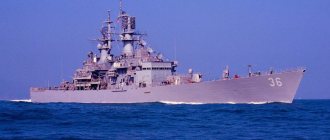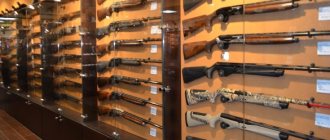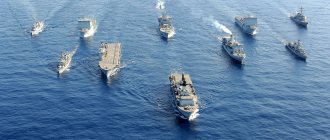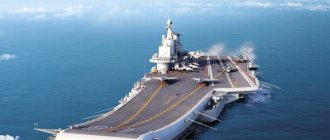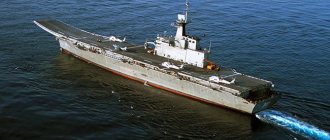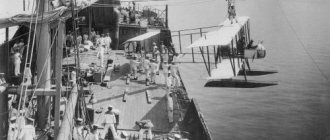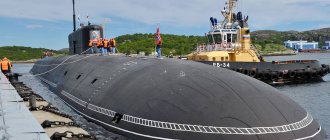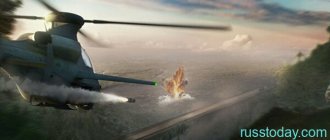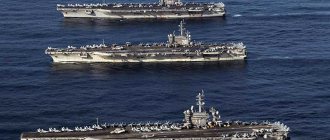The powerful navy of any state determines the political status of the country. For several centuries, Great Britain was considered the strongest maritime power. However, after the end of World War II, the United States of America took the palm. Nuclear-powered aircraft carriers are a significant strength of the country's Navy and a national treasure. The United States is the only country in the world with 11 operational aircraft carriers. The remaining 9 countries that own such vessels can boast one, maximum two pieces of equipment.
US aircraft carriers
- Aircraft carriers - Comparison by country - History of creation
Varieties
Aircraft carrier Ronald Reagan
Nimitz-class aircraft carriers
Independence-class aircraft carriers
Kitty Hawk-class aircraft carriers
Nimitz-class aircraft carriers
Essex-class aircraft carriers
Forrestal-class aircraft carriers
Midway-class aircraft carriers
History of the creation of US aircraft carriers
The idea of creating a floating runway belongs to the Americans. And this is not surprising. The main battles almost always take place off the coast of North America, and the United States has always sought to control any military conflicts.
In 1910, an airplane took off from a ship for the first time. It was the light American cruiser Birmingham, on which a wooden platform measuring 25x7 meters was erected. After 5 minutes, the aircraft, equipped with special floats, successfully landed on the water. The following year, an American officer successfully landed a plane on the artificially created enlarged deck of a cruiser. Carrying out further research, already in 1915 a catapult was developed, necessary for launching an aircraft from a ship.
During the First World War, the British fleet was actively used; after the end of hostilities, America carefully studied the actions of British naval aviation. The first US aircraft carrier was converted from a coal carrier and named CV-1 Langley. A 163-meter-long deck was created on the ship and cranes were installed to lift aircraft on board. The following ships, the aircraft carrier Lexington (CV-2) and the aircraft carrier Saratoga (CV-3), were converted from battleships during the construction phase.
CV-1 Langley
The year 1927 is an important date in the history of American aircraft carriers. This year, a decision was made to build (and not re-equip) the first five aircraft-carrying ships. Each of the ships could accommodate from 70 to 80 aircraft.
In the first half of the last century, aircraft-carrying ships of different sizes and, accordingly, differing in purpose, appeared in a number of countries. Several classes of ships were distinguished:
- Light aircraft carrier. The ship is small in size compared to analogues of another class, and can accommodate from 20 to 50 aircraft.
- Escort aircraft carrier. It is a subtype of light aircraft carrier. These ships were rebuilt from civilian ships. A feature of this technology was its low speed and unreliability in battles. Langley's first experimental aircraft carrier can be attributed specifically to this class of ships.
- Heavy/attack aircraft carrier. It is a type of large ship that allows horizontal takeoff and landing. Accommodates from 70 to 100 aircraft. Such naval equipment is capable of inflicting large-scale attacks on the enemy and can remain far from the coast for a long time. During the war and in the post-war period, US aircraft carriers such as the Essex and Midway were built.
Controversy over the method of destroying a warship
Before this ship, the US military had not sunk a single ship of this kind. The previous generation aircraft carrier was dismantled for scrap. The ship next to it was turned into a museum. And only this ship had the honor of serving as a test projectile and answering many of the creators’ questions about the ship’s shock resistance.
This decision caused a lot of protests among Americans. Many argued that it was wrong to subject a ship that bears the name of a great country to shelling and subsequent sinking.
However, as a result, almost ten years after the ship was decommissioned, it was towed to the ocean waters of Virginia. Previously, combat charges were placed in different parts of the ship, which exploded within a month, simulating the impact of combat shells in different parts of the ship.
A month later, the ship was still afloat and only later did it tilt on its bow and gradually sank.
Now it is located in the waters of the Atlantic Ocean several hundred kilometers from the coast of the United States at a depth of more than 6 km. In the summer of 2018, photos of the sinking of the aircraft carrier were declassified and found their way onto the Internet.
The Second World War
For the US Navy, the war began in December 1941, when Japan attacked the US Pacific Fleet base at Pearl Harbor. Over the course of two raids, 353 aircraft took off from 6 Japanese aircraft carriers. As a result of the attacks, 14 ships and more than 200 aircraft were sunk or damaged, and about 2.5 thousand people were killed. No one expected such aggression from Japan. The United States declared war on the “Land of the Rising Sun” on the same day. By coincidence, only old ships were in Pearl Harbor at the time of the attack. Modern aircraft carriers were located on another part of the American coast.
Essex-class aircraft carriers
In the same year, 1941, 3 Essex-class aircraft carriers were laid down, which belonged to the strike class of aircraft carrier ships. The design began 3 years before the start of construction. Initially, it was planned to build only one such ship. However, after the attack on the Pearl Harbor base, a decision was urgently made to create two additional ships. In total, 24 aircraft carriers of this type were produced during the war years. It is noteworthy that the Essex took part in many battles, but not a single ship was sunk. The length of the vessel was 266 m, the maximum speed reached 33 knots, the crew included 3,000 people (in accordance with the staffing table, 2,386 people). The equipment included about 100 aircraft, anti-aircraft artillery and radar weapons.
Essex-class aircraft carriers
| Type: Attack aircraft carriers "Essex" | ||
| Name | Commissioned | Removed from the fleet |
| "Essex" USS Essex (CV/CVA/CVS-9) | December 31, 1942 January 15, 1951 | January 9, 1947 June 30, 1969 |
| "Yorktown" USS Yorktown (CV/CVA/CVS-10) | April 15, 1943 January 2, 1953 | January 9, 1947 June 27, 1970 |
| "Intrepid" USS Intrepid (CV/CVA/CVS-11) | August 16, 1943 | March 15, 1974 |
| Hornet Hornet (CV/CVA/CVS-12) | November 29, 1943 March 20, 1951 September 11, 1953 | January 15, 1947 May 12, 1951 July 25, 1989 |
| "Franklin" USS Franklin (CV/CVA/CVS-13, AVT-8) "Big Ben" "Big Ben" | January 31, 1944 | February 17, 1947 |
| Ticonderoga USS Ticonderoga (CV/CVA/CVS-14) | May 8, 1944 October 1, 1954 | January 9, 1947 September 1, 1973 |
| "Randolph" USS Randolph (CV/CVA/CVS-15) | October 9, 1944 July 1, 1953 | February 25, 1948 February 13, 1969 |
| "Lexington" USS Lexington (CV/CVA/CVS/CVT/AVT-16) "The Blue Ghost" "The Blue Ghost" | February 17, 1942 | November 8, 1991 |
| "Bunker Hill" USS Bunker Hill (CV-17) | May 24, 1943 | January 9, 1947 |
| "Wasp" USS Wasp (CV-18) | November 24, 1943 | July 1, 1972 |
| "Hancock" USS Hancock (CV-19) | April 15, 1944 March 1, 1954 | May 9, 1947 January 31, 1976 |
| Bennington USS Bennington (CV-20) | August 6, 1944 | January 15, 1970 |
| "Boxer" USS Boxer (CV-21) | April 16, 1945 | December 1, 1969 |
| "Bon Homme Richard" USS Bon Homme Richard (CV-31) | November 26, 1944 October 1, 1952 | January 9, 1947 July 2, 1971 |
| "Leyte" USS Leyte (CV-32) | April 11, 1946 | May 15, 1959 |
| USS Kearsarge (CV-33) | March 2, 1946 | February 13, 1970 |
| "Oriskany" USS Oriskany (CV-34) | September 25, 1950 | September 30, 1976 |
| Antietam USS Antietam (CV/CVA/CVS-36) | January 28, 1945 | May 8, 1963 |
| Princeton USS Princeton (CV-37) | November 18, 1945 August 28, 1950 | June 21, 1949 January 30, 1970 |
| "Shangri-La" USS Shangri-La (CV-38) | September 15, 1944 February 1, 1955 | November 7, 1947 July 30, 1971 |
| "Lake Champlain" USS Lake Champlain (CV-39) | June 3, 1945 September 19, 1952 | February 17, 1947 December 1, 1969 |
| "Tarawa" USS Tarawa (CV/CVA/CVS-40, AVT-12) | December 8, 1945 February 3, 1951 | June 30, 1949 May 13, 1960 |
| Valley Forge USS Valley Forge (CV-45) | November 3, 1946 | January 15, 1970 |
| "Philippine Sea" USS Philippine Sea (CV-47) | May 11, 1946 May 15, 1959 | December 28, 1958 December 1, 1969 |
Long Island-class aircraft carriers
Considering the slow speed of construction of attack aircraft-carrying ships, a decision was made to re-equip a number of transport ships. An escort aircraft carrier could be built in a few months. In the early 40s, 2 transport ships were converted, one of which was transferred to the British Navy. The American Long Island was used primarily as a training base for pilots and escorts for other ships; only once did it take a mediocre part in ensuring security during the Battle of Midway. The ship had a length of 150 meters, a speed of about 16 knots and a crew of up to 1000 people. Armament included 16 aircraft. After the end of the war he was removed from service, but served for many years after that for civilian purposes until 1977.
Long Island type
Avenger-class aircraft carriers
During the same period, another 4 transport ships were converted into escort aircraft carriers, some of which were transferred to the US partner - Great Britain. The technical characteristics of the ship were practically no different from the Long Island-class aircraft carriers, except that not 16, but 15 aircraft were based on board. A German submarine was able to sink the main of the four ships described near Gibraltar.
Ranger-class aircraft carrier
The Ranger is the first attack ship originally designed as an American aircraft carrier. The runway looked like an above-deck structure made of wood and topped with a thin layer of steel for protection in case of fire. The chimney was divided into 6 pipes - three on each side. Depending on the direction of the wind, one or the other side was connected, thereby ensuring normal visibility for takeoff and landing of aircraft. The ship had been in service since 1934, patrolled the Atlantic Ocean during the war, and took part in 1942 operations in North Africa. During this time, 496 aircraft sorties were carried out from the ship. At the end of the war, the ship was withdrawn from the fleet and sold as scrap in 1947. The length of the Ranger was almost 235 meters, the speed was 29 knots, and the aviation group consisted of 86 aircraft.
Yorktown-class aircraft carriers
In the 30s of the last century, 3 aircraft-carrying ships were also built, which were a modernized copy of the Ranger. All of them were actively used in military battles. Just a year after the United States entered the war, 2 Yorktowns were sunk, and the third aircraft carrier, Enterprise, was withdrawn from service in 1947. The length of the ships was 246 meters, the speed was 32.5 knots, and each ship was assigned 96 aircraft. Particularly notable was the USS Enterprise, considered the most famous United States Navy ship in the Pacific during World War II. The ship took an active part in the battles at Midway Atoll.
It is worth talking in more detail about the Battle of Midway, since this battle was one of the most important that influenced the outcome of the war. Understanding the growing power of American aircraft carriers, Japan planned in detail a surprise attack on US naval forces based in the Midway Atoll area. However, US cryptographers managed to declassify the code and learned about the enemy’s tasks. Deciding to be proactive, Admiral Nimitz sent 3 fully equipped Yorktown-class aircraft carriers. As a result of heavy battles, Japan lost 4 heavy aircraft carriers and 248 aircraft and thereby missed the opportunity to conduct an attacking line of conduct in the war. The United States lost one of the Yorktown aircraft carriers in this battle.
| Type: Yorktown Attack Carriers | ||
| Name | Commissioned | Removed from the fleet |
| Yorktown USS Yorktown (CV-5) | September 30, 1937 | October 2, 1942 |
| Enterprise USS Enterprise (CV-6) | May 12, 1938 | February 17, 1947 |
| Hornet USS Hornet (CV-8) | October 20, 1941 | October 26, 1942 |
Wasp-class aircraft carrier
This type is represented by only one example of the ship. It was a stripped-down version of Yorktown. "Wasp" was put into operation in 1940, with the beginning of US participation in the war, the ship patrolled the waters of the Atlantic Ocean and repeatedly transported land aircraft from England to the Mediterranean. In 1942, Wasp and its aircraft ensured the safe passage of American ships. However, a Japanese submarine met on his way. When attacked by the Japanese Navy, the aircraft carrier was damaged and then sunk.
Independence-class aircraft carriers
In conditions of an acute shortage of aircraft carriers during the Second World War, several more light aircraft-carrying ships (Independence class) were created, rebuilt from the Cleveland cruisers. Over the course of 2 years, 9 such vessels were converted. Despite their small size and vulnerability, they were actively exploited during the war. After the war and the development of aviation, the small size of the deck did not allow aircraft carrier cruisers to be used for their intended purpose, so in 1946-47 all of them were withdrawn from US Navy service. Some of them were transferred to the navies of France and Spain, some were used in nuclear tests, and the rest were scrapped. The Independence was 190 meters long and could accommodate up to 30 aircraft.
Independence-class aircraft carriers
| Type: Light aircraft carriers "Independence" | ||
| Name | Commissioned | Removed from the fleet |
| Aircraft carrier USS Independence (CVL-22) | January 1, 1943 | August 28, 1946 |
| Princeton USS Princeton (CVL-23) | February 25, 1943 | October 24, 1944 |
| "Bello Wood"/"Bois Belleau" Belleau Wood/Bois Belleau | March 31, 1943 (USA) December 23, 1953 (France) | 1960 |
| Langley/La Fayette Langley/La Fayette | August 31, 1943 (USA) June 2, 1951 (France) | February 9, 1964 |
| "Cabot"/"Dedalo" Cabot/Dedalo | November 17, 1943 (USA) August 30, 1967 (Spain) | 1989 |
Saipan-class aircraft carriers
A group of light aircraft carriers from the 1940s, created as replacements for the supposed losses of the Independence. Two ships of this type were built, both of which never entered service during wartime. At the end of the war, the intensive development of jet aircraft began; Saipan could no longer take such heavy equipment on board. In view of this, the ships acted as auxiliary vessels or training exhibits and were withdrawn from service only at the end of the 70s of the last century.
Bogue-class aircraft carriers
A group of World War II escort aircraft carriers, most often used by the British Allies. A total of 45 units of equipment were converted. The distinctive features of these escort aircraft carriers were the following indicators. Due to a shortage of diesel engines, the Bogue used a hull with steam turbine units - this increased the amount of gas produced, but also contributed to the vessel's greater speed. The length of the ship was increased, and the deck itself was protected by 6-mm steel sheets, all this made it possible to take on board heavier aircraft.
Bogue type
Casablanca-class aircraft carriers
The largest group of escort aircraft carriers, 50 units were created during the war, the ships were built in a record 4 months. "Casablanca" differed from "Bogue" in greater speed and increased hangar space, but they could not cover long distances. Also, their deck was shorter than the previous Bogues, so take-off and landing of aircraft was difficult. During the war, aircraft carriers were actively used to support landing forces. 5 ships were lost during the battles. At the end of hostilities, the Casablanca became unusable due to its small deck size.
Sengamon-class aircraft carriers
Four Sangamon-class escort carriers were converted from unfinished oil tankers and also served in World War II. The ships served in the Atlantic and later the Pacific Ocean. The cost of such ships was quite high, so not a large amount of equipment was built. All of the Sangamon aircraft carriers were involved in Operation Torch. The aircraft armament included 14 fighters and 17 bombers of various types. During one of the campaigns, the Sengamon was discovered by Japanese ships. The aircraft carrier tried to break away from the enemies, but the very next day it was attacked by a plane that crashed into the deck. The hole on the deck reached 40 m², a few minutes later the aircraft carrier was torpedoed by a submarine. On the same day, 2 more kamikazes crashed into the side of the ship, leaving more and more holes and hundreds of dead. Despite this, the Sengamon continued to sail.
Ship of Presidents
"Carl Vinson" is an aircraft carrier that entered service in May 1982. The ship is named after the congressman who served as head of the Armed Services Committee for 29 years. The ship's main duty stations were the Indian and Pacific Oceans, as well as the Persian Gulf. The ship was involved in the filming of the film “Top Gun”.
After the destruction of Osama bin Laden in the spring of 2011, his body was delivered to this aircraft carrier, after which it was sent to the waters of the Arabian Sea. And six months later, Barack Obama and his wife attended a basketball match between student teams, which was held on the deck of this sea giant.
Post-war time
Naval battles in World War II demonstrated the need to use aircraft carriers for a variety of purposes. Shock units took a direct part in many significant battles. Escort and light analogues ensured the safety of the movement of other ships, transported aircraft and acted as training equipment. Having won the victory, the United States, together with its allies, continued the development of naval aviation and, as a result, a new aircraft carrier capable of carrying heavy jet aircraft was required. In view of this, most of the existing aircraft-carrying ships were decommissioned and new, more modern and modernized ones took their place.
Taking into account the development of technology and shipbuilding, the following modern classes of aircraft-carrying ships have been developed:
- A supercarrier is a large attack aircraft carrier, which in modern times most often has a nuclear installation on board. The displacement ranges from 50 to 100 thousand tons. They include a large number of aircraft with the ability to take off and land horizontally. They are called strike ships because they are capable of independently delivering a powerful blow to the enemy, without the use of additional ships. Such aircraft carriers have the capability of long-term voyages.
- A multi-purpose aircraft carrier is a vessel with a displacement of 30-50 thousand tons with the possibility of horizontal landing. The ships are similar in function to supercarriers, but are smaller in size, have fewer aircraft on board, and can stay less offshore.
- Light aircraft carrier - displacement does not exceed 25 thousand tons, it uses only vertical take-off and landing aircraft. Therefore, such an aircraft carrier is called a VTOL aircraft. They are not as powerful as previous classes, but their cost is several times cheaper. In this regard, some countries use these types of vessels.
Midway-class aircraft carriers
The first group of heavy attack aircraft carriers were produced in the likeness of their British counterparts. The Midway class differed from its predecessors in its larger size and more powerful hull armor. Unlike the 25 mm armor of all previous generations, this type had a deck thickness of 87 mm. During the war and post-war period, 3 copies were built, but none of them managed to see the battles of World War II. At the same time, the ships participated in a number of other battles taking place around the world, including the Vietnam conflict. Two of the three aircraft carriers have undergone modernization and have been in the fleet for almost 50 years. The length of the vessel was 295 meters, the number of aircraft in different periods varied from 136 to 153 aircraft. The last aircraft carrier was decommissioned in 1992 and today is a museum exhibit.
| Type: Attack aircraft carriers "Midway" | ||
| Name | Commissioned | Removed from the fleet |
| "Midway" USS Midway (CV-41) | September 10, 1945 | April 11, 1992 |
| Franklin D. Roosevelt USS Franklin D. Roosevelt (CV-42) | October 27, 1945 | September 30, 1978 |
| "Coral Sea" USS Coral Sea (CV-43) | October 1, 1947 | April 26, 1990 |
Operation Gusty Wind
"Midway" participated in the special operation "Gusty Wind". In 1975, the country's leadership sent several aircraft carriers to the shores of Vietnam to evacuate the residents of Saigon. A South Vietnamese Air Force pilot put his wife and 5 children into a small two-seater plane and flew out of the danger zone. In the vastness of the sea, he saw Midway and asked to land the aircraft on an aircraft-carrying ship. To be able to land the plane, it was necessary to quickly clear the deck of equipment. The captain of Midway gave the order to remove aircraft from the deck. Some of them had to be jettisoned, resulting in $10 million in aviation losses. To the surprise of everyone present on the ship, the pilot managed to land the plane and saved the family.
Forrestal-class aircraft carriers
The next on the list of heavy attack aircraft carriers were the Forrestal-class ships, created in the 50s of the last century. The need for them arose after an analysis of naval battles in the area of the Korean Peninsula. 4 ships were built - these were the largest warships in the world in the entire history of shipbuilding at that time. The length was 317 meters; thanks to the new technical equipment, the aircraft carrier could sail autonomously for 90 days. Armament included radar equipment, anti-aircraft artillery and up to 90 aircraft. "Forrestal" participated in the Vietnam War and represented the basic set of ships in the US Navy. The last of the ships was taken out of service in 1998.
"Forrestal" USS Forrestal (CV-59)
| Type: Forrestal attack aircraft carriers | ||
| Name | Commissioned | Removed from the fleet |
| "Forrestal" USS Forrestal (CV-59) | October 1, 1955 | September 11, 1993 |
| Saratoga USS Saratoga (CV-60) | April 14, 1956 | August 20, 1994 |
| "Ranger" USS Ranger (CV-61) | August 10, 1957 | July 10, 1993 |
| USS Independence (CV-62) | June 6, 1958 | January 10, 1959 |
Kitty Hawk-class aircraft carriers
Following the combat testing and service of the previous Forrestal series of aircraft carriers, several elements in the design of the ships were corrected. In the 60s, the world saw 4 examples of improved models called “Kitty Hawk”. The main difference from its predecessors was the enlarged deck and different placement of elevators. The length was 326 meters, the crew reached 5,624 people - excluding air pilots, there were about 80 planes and helicopters on board. The last of the aircraft carriers was withdrawn from the fleet in 2009.
USS Constellation (CV-64) Kitty Hawk type
| Type: Kitty Hawk attack aircraft carriers | ||
| Name | Commissioned | Removed from the fleet |
| "Kitty Hawk" USS Kitty Hawk (CV-63) | April 21, 1961 | January 31, 2009 |
| "Constellation" USS Constellation (CV-64) | October 27, 1961 | August 7, 2003 |
| "America" USS America (CV-66) | August 23, 1965 | August 9, 1996 |
| "John Kennedy" USS John F. Kennedy (CV-67) | September 7, 1968 | August 1, 2007 |
Peace ship
In conclusion, finishing our consideration of the question of how many aircraft carriers there are in the United States, let us pay attention to a ship of this type called the Dwight Eisenhower.
This combat vessel was commissioned in 1977. In the period 1985-1987, the ship was undergoing its first planned reconstruction, and the second occurred in 2001-2005. For almost twenty years, the aircraft carrier was “peaceful” and did not take part in any military operations. However, in 1991 he was drawn to the war zone - the Persian Gulf. In 2000, the ship maintained no-fly zones in Iran during Operation Southern Watch.
The emergence of nuclear aircraft carriers
With the development of nuclear power, many marine experiments and tests were carried out. For this purpose, they used a number of aircraft carriers that survived the Second World War, but were not able to take on board new heavy aircraft. After conducting a series of studies, America decided to do the incredible. Construction began on a fundamentally new aircraft-carrying vessel, the likes of which had no analogues in the world. It was the nuclear attack super aircraft carrier Enterprise. It was put into operation in 1961.
Initially, it was planned to build 5 similar ships. However, given the huge cost of $451 million, it was decided to settle on a single copy.
Its length is 342 meters. The possibility of autonomous navigation reached 13 years. This was many times greater than the capabilities of all other aircraft carriers in the United States and the world. Enterprise served in the Cuban Missile Crisis and the Vietnam War.
In 1969, a tragic event occurred: one of the missiles, due to the negligence of the crew, exploded and crashed into the tank of one of the aircraft standing on the deck. The disaster killed 27 people, and total property damage amounted to $126 million.
After repair work and modernization of a number of elements, the ship continued to participate in combat operations. In particular, in Afghanistan and Iraq. In 2011, he was spotted off the coast of Somalia, where he helped in the fight against sea pirates. In 2012, the aircraft carrier was withdrawn from the fleet. However, it was only in February 2017 that it was officially decommissioned. This was due to the fact that the US Navy planned to replace the Enterprise with a new American supercarrier, which would not be ready until 2022.
Nimitz-class aircraft carriers
The main aircraft carriers currently operating in the US Navy are Nimitz-class vessels. The ships, like the Enterprise and the new Ford, have a nuclear power plant. The first ship of this type was put into operation in 1975, the last in 2009. The production cost is $4.5 billion, operation is possible for 50 years. The recharge period of a nuclear reactor is 20 years. A total of 10 units were produced.
Nimitz aircraft carriers took an active part in operations related to military conflicts in Yugoslavia and Iraq. It is unknown how high-quality armor is installed on US aircraft carriers, since they are currently in use, but there is reason to believe that 63.5 mm thick Kevlar plates were used during production. Such protection is not enough against a direct hit from modern missiles, but the US Navy's air defense systems will prevent these missiles from approaching the danger zone around the ship.
Attack aircraft carrier Nimitz
| Type: Nimitz attack aircraft carriers | ||
| Name | Commissioned | Removed from the fleet |
| "Nimitz" USS Nimitz (CVN-68) | May 3, 1975 | Is in service |
| "Dwight Eisenhower" USS Dwight D. Eisenhower (CVN-69) | October 18, 1977 | Is in service |
| "Carl Vinson" USS Carl Vinson (CVN-70) | May 13, 1982 | Is in service |
| "Theodore Roosevelt" USS Theodore Roosevelt (CVN-71) | October 25, 1986 | Is in service |
| "Abraham Lincoln" USS Abraham Lincoln (CVN-72) | November 11, 1989 | Is in service |
| "George Washington" USS George Washington (CVN-73) | July 4, 1992 | Is in service |
| "John C. Stennis" USS John C. Stennis (CVN-74) | December 9, 1995 | Is in service |
| "Harry Truman" USS Harry S. Truman (CVN-75) | July 25, 1998 | Is in service |
| "Ronald Reagan" USS Ronald Reagan (CVN-76) | July 12, 2003 | Is in service |
| "George Bush" USS George HW Bush (CVN-77) | January 10, 2009 | Is in service |
DECK AVIATION
The US carrier fleet has carrier-based aircraft that have no analogues in the world in terms of numbers and combat power. As of 2013, the US Navy had 765 F/A-18 Super Hornet fighter-bombers of various modifications. These aircraft are the main striking force of the American aircraft carrier fleet.
In addition to fighter-bombers, as of 2013, the US Navy had:
- 85 Lockheed S-3 Viking anti-submarine aircraft,
- 170 Lockheed P-3 Orion patrol aircraft,
- 127 transport aircraft of various models,
- 65 carrier-based AWACS aircraft,
- 87 carrier-based electronic warfare aircraft "Grumman" EA-6B and 1 EA-18G,
- more than 500 deck helicopters of various models.
Organizationally, the carrier-based aviation of the US Navy consists of the air forces of the Atlantic and Pacific fleets. Those, in turn, consist of air wings, which are divided into squadrons.
Let's look at the main types of aircraft in service with the US Navy's carrier-based aircraft.
F/A-18C AND F/A-18E HORNET AIRCRAFT
F/A-18 fighter |
Manufacturer: .
Power plant: two General Electric F414-GE-400 turbofan engines
Maximum speed at altitude: 1915 km/h.
Flight range with external fuel tank: 3300 km.
Service ceiling: 15500 m.
Armament: 20-mm M61A1/A2 “Vulcan” automatic cannon; on an external sling, the aircraft can carry over 8,000 kg of other weapons, including almost all the bombs and missiles used by the US Navy.
F-35C SINGLE STRIKE FIGHTER
A promising carrier-based fighter-bomber of the fifth generation.
Manufacturer: .
Power plant: forced turbofan engine "Pratt & Whitney" F135 with afterburning thrust 13,000 kgf, afterburner 19,500 kgf.
Maximum speed at altitude: 1907 km/h.
Flight range: 1150 km.
Service ceiling: 14400 m.
The F-35C features large folding wings and stabilizers that improve low-speed performance, as well as a more robust landing gear that can withstand the shock of landing on the deck of an aircraft carrier. Higher area wings will increase range and payload capacity, and with full internal tanks the fighter will have twice the range of the F/A-18C and will be able to perform virtually the same missions as the heavier Super Hornet. The fuselage houses a four-barreled 25mm GAU-22/A cannon and has 4 internal and 6 external hardpoints that can accommodate a variety of missile weapons.
AIRCRAFT AWACS E-2 "HOKAY"
E-2 Hawkeye |
Manufacturer: Northrop Grumman.
Power plant: two Allison T56 turboprop engines.
Maximum speed: 695 km/h.
Flight range: 2975 km.
Service ceiling: 9400 m.
Weapon: none.
The E-2 Hawkeye reconnaissance aircraft is the “eye in the sky” of the carrier strike group. The latest modification of this aircraft can monitor two thousand targets at once (and detect twenty thousand targets simultaneously) at distances exceeding 650 km, and simultaneously direct from forty to one hundred aircraft to targets.
How many aircraft carriers does the US have today?
The US Navy operates 11 nuclear-powered attack aircraft carriers. American aircraft carriers are significantly more powerful than all other aircraft carriers in the world combined.
Gerald R. Ford (CVN-78)
The latest development in the field of aircraft carriers is represented by the new Ford-class ship, which entered the ranks of the American Navy on May 31, 2017. Today, among the operating aircraft carriers in the world, Ford is the largest specimen. The cost of its construction cost the Americans almost 13 billion dollars. The vessel is equipped with an Emals electromagnetic catapult, which ensures smoother acceleration of aircraft. The new reactors are capable of creating 25% more electricity than its predecessor. Thanks to the increased number of automated elements, it was possible to reduce the number of people involved in operation. Thus, there are savings in the use of the ship in the amount of 4 billion dollars. The Gerald R. Ford has the ability to sail autonomously for up to 30 years.
Team Core
Despite how many aircraft carriers the United States has now and how many there will be in the future, these ships were, are and will be the backbone of the carrier strike group. Moreover, any such vessel does not have its own powerful defensive weapons and is not adapted to carry out independent actions. An aircraft carrier moves along the water surface under the cover of other ships. A distinctive feature of the strike group is its ability to cover a distance of almost 1,500 kilometers in a day and at the same time remain unnoticed by a potential enemy.
